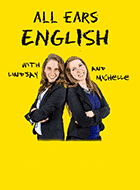
Daylight savings time is Sunday in the United States!
Do you know what this is all about?
There are two times per year where we change the clocks, and it can be confusing even for natives.
Understanding how this all works can help you to know how to talk about these time changes in your daily conversations with native English speakers.
We’re going to help you to understand what happens and how you can talk about this in today’s episode.
Get Your Transcripts

Make sure you understand every word you hear on All Ears English.
Bring your English to the advanced level with new vocabulary and natural expressions.
Get the transcripts from today’s episode.
Learn to speak naturally with the American accent.
Click here to subscribe to the transcripts and save 50%
We have a listener question about a special phrase that goes with this time of year.
Hi, there!
I am Jing from China.
I overheard a native phrase which is “Spring ahead, fall back”. It says you guys shift your clocks an hour ahead when it’s Spring time, and one hour back when Fall comes.
That shocks me a lot. I’d like to confirm whether it’s true or not in the USA.
Thanks for your consistent podcast–thumbs up!
Cutting Through The Confusion
This is a great question because this whole issue can be confusing for many of us.
As mentioned, this phrase has to do with what we call daylight savings time.
That’s the term to use because it’s universal and most people understand what that means.
Daylight savings is when we turn the clocks forward in March as the days get longer.
This isn’t done in many other countries outside of the US, so it can contribute to confusion.
So How Does It All Work?
It can help to know exactly how it all works so that you are not further confused.
If it’s 1pm one day then it will be 2pm at that same time the next day.
This applies for “spring forward” when we turn our clocks forward on a designated day in March.
You actually lose an hour for that one day, but you get used to it pretty quickly.
If it’s 4pm one day, then it’s 3pm the next day when you fall back.
You essentially gain an hour here as you turn your clocks back to make up for shorter daylight hours.
Daylight savings time ends in november when the clocks are turned back one hour.
This is when you fall back to allow for that extra hour of daylight when that time period gets shorter.
How Do People Feel About The Time Change?
If you ask most people how they feel about the time change they will often say they don’t like it.
It’s depressing in November when it gets darker earlier!
Some people enjoy when it happens because you get an extra hour of sleep.
Though you do lose an hour in March, you get used to the change.
It can be hard to have shorter days, especially for some people.
It does take people a few days to get over the time change–it’s a weird feeling.
Using The Phrase
So let’s get to the phrase! “Spring forward, fall back.”- what does this have to do with daylight savings time?
It’s a way to remember what to do when you really think about it.
Because in general we would say spring forward, not spring back.
It makes it easy to remember what to do with your clock-go forward or back an hour–so you don’t make a mistake!
So if you want to talk about daylight savings time, you can do so by saying things like
“Don’t forget to turn your clocks forward/back tonight!”
“I can’t wait for the extra hour of sleep/the extra daylight”
Takeaway
Spring forward fall back is a great way to remember what to do when the clocks change an hour either way.
It helps you to remember and people don’t really say this as much as they simply think it to themselves.
Try having conversations with people about daylight savings time–this is one of those things where people often have strong opinions,
It’s a great way to start a conversation about something that affects so many of us though.
If you have any questions, please leave them below in the comments section.
We’ll get back to you as soon as we can.








